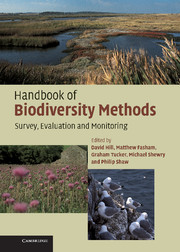Book contents
- Frontmatter
- Contents
- Preface
- Acknowledgements
- Part I Planning
- Part II Habitats
- 4 Introduction to habitat evaluation
- 5 Habitat requirements and issues
- 6 Methods for surveying habitats
- 7 Surveying and monitoring management or environmental impacts
- 8 Habitat conservation evaluation criteria
- Part III Species
- Appendix 1 Monitoring and reporting obligations under international conservation agreements
- Appendix 2 Relationship between BAP Priority Habitat and Broad Habitat categories and Habitats Directive nomenclature
- Appendix 3 Annotated list of key references for plant identification
- Appendix 4 Determining appropriate quadrat size for vegetation sampling
- Appendix 5 The relocation of permanent plots
- Appendix 6 Equipment required for undertaking different types of survey
- Recommended sources of further information
- References
- Glossary
- Index
4 - Introduction to habitat evaluation
Published online by Cambridge University Press: 01 September 2010
- Frontmatter
- Contents
- Preface
- Acknowledgements
- Part I Planning
- Part II Habitats
- 4 Introduction to habitat evaluation
- 5 Habitat requirements and issues
- 6 Methods for surveying habitats
- 7 Surveying and monitoring management or environmental impacts
- 8 Habitat conservation evaluation criteria
- Part III Species
- Appendix 1 Monitoring and reporting obligations under international conservation agreements
- Appendix 2 Relationship between BAP Priority Habitat and Broad Habitat categories and Habitats Directive nomenclature
- Appendix 3 Annotated list of key references for plant identification
- Appendix 4 Determining appropriate quadrat size for vegetation sampling
- Appendix 5 The relocation of permanent plots
- Appendix 6 Equipment required for undertaking different types of survey
- Recommended sources of further information
- References
- Glossary
- Index
Summary
HOW TO USE THE HANDBOOK A RECAP
Part II of the Handbook is intended as a general-purpose source of detailed, practical information on study design, sampling and analysis as well as on the most commonly used methods for surveying and monitoring terrestrial and freshwater habitats.
The development and successful implementation of a survey and monitoring programme involves making a series of crucial decisions. Part II of the Handbook is therefore designed to provide a step-by-step guide through the process of planning and executing a survey and monitoring programme. However, the design and implementation of a programme is not a linear process, but often involves iterative steps that depend on the outcome of other decisions. Because monitoring is largely defined by a series of surveys, the term ‘survey’ is usually also implied where the term ‘monitoring’ is used throughout this Handbook. The main topics covered in Part II are listed below.
HABITAT SURVEY AND MONITORING
This chapter identifies the attributes of major habitat types that provide an indication of their condition. These should be the focus of habitat condition monitoring programmes. For each habitat a summary table lists these attributes and provides cross-references to descriptions of the recommended methods for monitoring them (provided in Chapter 5). Reference should also be made to generic guidelines on defining Condition Objectives for statutory sites that are being developed by the UK conservation agencies (visit their websites for latest information).
- Type
- Chapter
- Information
- Handbook of Biodiversity MethodsSurvey, Evaluation and Monitoring, pp. 105 - 106Publisher: Cambridge University PressPrint publication year: 2005

